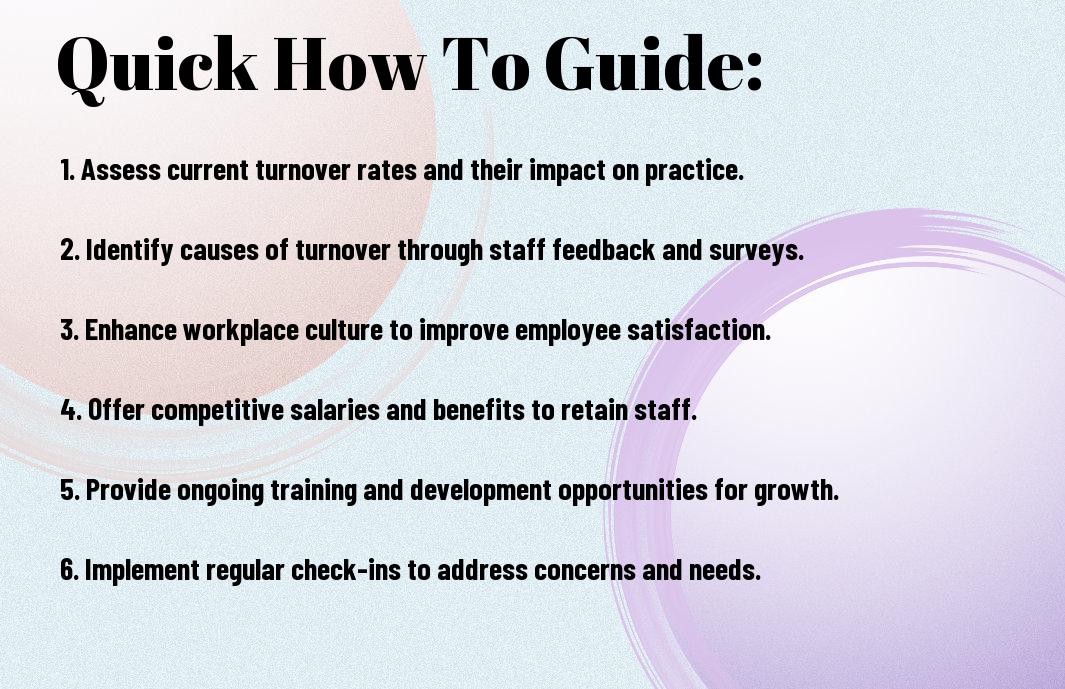The Hidden Costs of Staffing Turnover in Dentistry (and How to Fix It)
Most dental practices underestimate the hidden costs associated with staffing turnover, which can be detrimental to both your finances and patient care. In my experience, these costs often extend beyond just recruitment expenses; they can impact team morale and overall productivity. In this blog post, I’ll guide you through the various expenses tied to high turnover rates and share effective strategies to reduce turnover while enhancing your practice’s culture and stability. By understanding these costs, I aim to help you maintain a thriving dental practice that prioritizes both your team and your patients.
Key Takeaways:
- High staffing turnover can lead to increased costs related to hiring, training, and onboarding new staff, negatively impacting the practice’s budget.
- Patient care and satisfaction may decline as new employees take time to learn established procedures and build relationships with patients.
- Employee retention strategies, such as offering competitive compensation and fostering a positive work environment, can significantly reduce turnover rates.
- Regular feedback and clear career development opportunities can enhance employee engagement and loyalty, further decreasing turnover.
- Implementing a structured training program for new hires can streamline onboarding, ensuring consistency in patient care and reducing lost revenue during transition periods.

Understanding the True Cost of Dental Staff Turnover
A high turnover rate in your dental practice can be detrimental not just financially, but also operationally. You might think the impact stops at hiring new staff, but the true cost extends into various aspects of your practice and patient care. Understanding these hidden costs can enhance your approach to staffing and retention, leading to a more profitable and harmonious work environment.
Direct Financial Impacts
The direct costs associated with dental staff turnover often include recruitment expenses, training costs, and lost productivity. Hiring a new team member requires you to invest in advertising open positions, conducting interviews, and onboarding. Additionally, the time spent training them can divert resources from patient care, ultimately affecting your bottom line.
Indirect Operational Consequences
With frequent turnover, your practice faces several operational challenges that can disrupt efficiency and patient experience. You may find that team dynamics suffer, leading to a less cohesive working environment and lower employee morale. This can cascade into decreased patient satisfaction as new staff may not yet be familiar with established protocols or the unique culture of your practice.
Cost implications are not always straightforward. For instance, when experienced team members leave, it may lead to a gap in knowledge and skills required for efficient practice. This can create situations where the remaining staff feel overwhelmed, potentially resulting in burnout or lowered service quality. Furthermore, if patients perceive instability in the staff, they may choose to seek care elsewhere, affecting your long-term patient retention rates. By recognizing and addressing these indirect consequences, you can foster a more stable and productive work environment.

Key Factors Contributing to High Turnover in Dental Practices
There’s a multitude of factors that can lead to high turnover in dental practices, including compensation, work environment, and staff recognition. These elements often intertwine, creating a challenging atmosphere for both employees and management. When team members feel undervalued or unsupported, their motivation dwindles, prompting them to seek opportunities elsewhere. Thou must understand that addressing these issues is vital for developing a stable workforce.
Compensation and Benefits Issues
To effectively retain staff, compensation and benefits must align with industry standards. Adequate pay not only attracts quality candidates but also keeps existing employees satisfied. If your dental practice lags in this area, you risk losing valuable team members to competitors offering better remuneration packages.
Work Environment and Culture Challenges
Even though many dental practices focus on clinical excellence, they often overlook the importance of a positive work culture. A negative or toxic atmosphere can lead to employee dissatisfaction and increased turnover rates. Creating a supportive environment fosters collaboration and boosts morale, ultimately benefiting patient care.
It’s necessary to recognize how a thriving work culture can transform your dental practice. By cultivating open communication, promoting teamwork, and celebrating achievements, you can create a welcoming environment that encourages loyalty. Investing time and resources into team-building activities and employee recognition can help mitigate feelings of burnout and disengagement, thereby significantly reducing turnover rates.
How to Calculate Your Practice’s Turnover Costs
Despite the common belief that turnover costs are only about lost productivity, they can extend well beyond that. Understanding the full financial impact of turnover in your dental practice requires a comprehensive analysis of both direct and indirect costs. By taking into account factors such as recruitment expenses, training time, and the potential loss of patients, I can better estimate how turnover affects my bottom line and strategize on effective solutions.
Developing a Cost Analysis Framework
Costs associated with turnover can be categorized into several buckets: recruitment expenses, training and onboarding costs, and productivity losses. By itemizing these elements, you create a framework that can highlight both the immediate and long-term effects of staffing changes on your practice. This detailed breakdown will provide a clearer picture of how turnover impacts your overall profitability and resource allocation.
Interpreting Turnover Metrics for Your Practice
Some metrics are key indicators of how turnover impacts your dental practice. Metrics like turnover rate, length of tenure, and remaining staff engagement can help me gauge the health of my team. These figures aren’t merely numbers; they provide insights about the morale and stability of my dental practice, guiding my decisions to create a more positive working environment.
To research deeper, understanding the nuances behind turnover metrics can illuminate important aspects of your practice’s culture. For example, if the turnover rate is unusually high, it may indicate underlying issues such as low employee satisfaction or inadequate support systems. Conversely, a low turnover rate could signify a healthy workplace culture where staff feels valued and engaged. By closely analyzing these metrics, I can make informed improvements and foster a more stable and productive environment.
Effective Recruitment Strategies to Reduce Turnover
Once again, understanding effective recruitment strategies can significantly lower staffing turnover in your dental practice. By focusing on attracting the right candidates from the start, you’ll not only improve your team’s stability but also enhance the overall patient experience. Implementing effective recruitment techniques involves clarity, thoroughness, and a commitment to finding individuals who align with your practice’s values and objectives.
Creating Compelling Job Descriptions
Some job descriptions I’ve encountered fail to convey the true essence of the position. To attract the best candidates, it’s vital to craft job postings that outline the role’s responsibilities, required skills, and the unique culture of your practice. By including information about growth opportunities and the benefits of working with you, I can appeal to passionate professionals who share your vision.
Implementing Structured Interview Techniques
You may find that structured interview techniques lead to more consistent and fair hiring practices. Instead of relying solely on gut feelings, incorporating a standardized set of questions allows for better comparisons among candidates, ensuring you’re selecting the best fit for your dental team.
Reduce hiring errors by implementing structured interview techniques that focus on objective criteria rather than subjective impressions. When you ask each candidate the same questions, you create a level playing field where their skills and experiences can be evaluated consistently. This approach not only minimizes bias but also helps you identify candidates who excel in key areas necessary for success in your practice. Additionally, I recommend enlisting a panel of interviewers, which brings diverse perspectives to the process and fosters a more engaging experience for applicants. With these practices in place, you will enhance the chances of selecting a candidate who is not only qualified but also a great cultural fit for your practice.
Staff Retention Tips That Actually Work
Many dental practices face challenges with staff turnover that can impact the overall success of the business. Here are some effective tips to improve staff retention:
- Foster a positive work culture
- Offer competitive compensation packages
- Provide professional development opportunities
- Recognize and reward achievements
- Encourage open communication
Any of these strategies can help create a more engaged and loyal team.
Competitive Compensation Packages
With competitive compensation packages, you can attract top talent and keep your best employees. Offering salaries that reflect industry standards and providing additional benefits like health insurance, retirement plans, and bonuses can significantly influence staff morale and commitment. Prioritizing fair pay can lead to a motivated workforce dedicated to your practice’s success.
Professional Development Opportunities
Compensation isn’t the only factor in retaining skilled team members; investing in professional development opportunities can also play a vital role. Providing training, workshops, and conferences encourages your employees to sharpen their skills, which can enhance their job satisfaction and career growth.
Staff members often seek environments where they can thrive and enhance their skills. By offering continuous learning opportunities, such as mentorship programs or access to advanced training, you stimulate their desire for professional advancement. This not only increases your team’s confidence and competence but also fosters a sense of loyalty and commitment. Effectively, an investment in your team’s professional growth translates into lower turnover rates and contributes positively to your practice’s overall performance.
Building a Practice Culture That Fosters Loyalty
All successful dental practices thrive on strong, positive cultures that promote loyalty among team members. By intentionally creating an environment where everyone feels valued and engaged, I can enhance my team’s commitment and significantly reduce turnover rates. This culture fosters open communication, teamwork, and shared goals, which ultimately contribute to a more stable and satisfied workforce.
Enhancing Team Communication
Even small improvements in communication can lead to a more cohesive team. Regular meetings and check-ins allow everyone to express their thoughts, share ideas, and collaborate on problem-solving, paving the way for enhanced trust and dedication across the practice.
Recognition and Appreciation Systems
You can make a substantial impact on team morale by implementing recognition and appreciation systems. By acknowledging individual contributions and celebrating team successes, I can foster a sense of belonging that motivates my staff to remain loyal to the practice.
Communication is key to ensuring that recognition feels sincere and impactful. Establishing a structured system for regularly recognizing efforts encourages a positive atmosphere where employees feel appreciated for their hard work. This can take the form of monthly awards, shout-outs during team meetings, or even personalized notes of appreciation. When I prioritize positive reinforcement, I not only uplift my staff but also create an environment where loyalty flourishes, and team members feel supported in their roles. This attention to appreciation reduces turnover and builds a fulfilling workplace culture.
Final Words
To wrap up, I urge you to consider the hidden costs of staffing turnover in your dental practice. You may not realize how much employee retention impacts your operational efficiency and patient satisfaction. By implementing strategies such as improved communication, fostering a positive workplace culture, and offering professional development opportunities, you can enhance employee loyalty and reduce turnover rates. Investing the time and resources into your team’s satisfaction pays off in the long run, benefiting both your practice and your patients.
FAQ
Q: What are the primary hidden costs associated with staffing turnover in dentistry?
A: The hidden costs of staffing turnover in dentistry can include decreased productivity, lost patient relationships, recruitment and training expenses, potential errors due to inexperienced staff, disruption in team dynamics, reduced employee morale, and the impact on overall patient care quality.
Q: How does staffing turnover negatively impact patient relationships?
A: Frequent turnover can lead to inconsistency in patient care, making it difficult to build trust between staff and patients. Patients may feel unsettled by the changing faces they encounter during visits, which could deter them from returning and affect their overall loyalty to the practice.
Q: What are the financial implications of recruiting new dental staff?
A: Recruiting new staff entails various expenses, including advertising for the position, background checks, recruitment agency fees, and the time cost incurred by existing staff who must participate in interviews. These costs can significantly add up and affect the overall budget of a dental practice.
Q: How long does it typically take to train a new dental employee to reach full productivity?
A: On average, it can take anywhere from several weeks to a few months for a new dental employee to reach full productivity. The timeline depends on the position and the individual’s prior experience, as well as the complexity of the practice’s procedures and policies.
Q: What can dental practices do to retain staff and decrease turnover rates?
A: Dental practices can promote staff retention by fostering open communication, offering competitive salaries and benefits, providing opportunities for professional development, recognizing and rewarding employee contributions, and creating a positive work environment that supports teamwork and collaboration.
Q: How do inexperienced staff members impact the quality of patient care?
A: Inexperienced staff may lead to mistakes in patient care, such as improper handling of equipment or incorrect administrative processes. This not only jeopardizes patient safety but can also create dissatisfaction, complaints, and potentially legal issues, ultimately affecting the practice’s reputation.
Q: What strategies can a dental practice implement to minimize the disruption caused by turnover?
A: To minimize disruption, dental practices can develop a structured onboarding process, create a comprehensive training program, implement mentorship opportunities, and establish clear expectations and responsibilities for all team members. Additionally, fostering a supportive culture can enhance employee engagement and reduce the chances of turnover.






